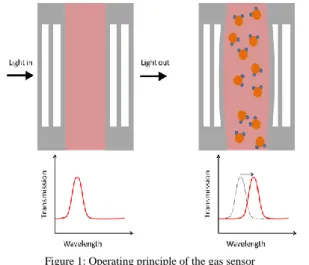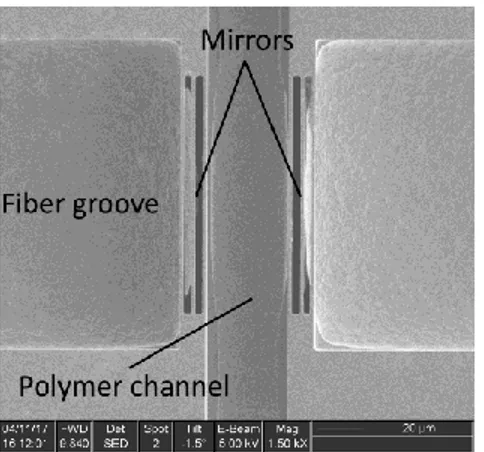Titre:
Title:
Selective in-plane Fabry-Pérot gas sensor functionalized with
polymer
Auteurs:
Authors:
Philippe Jubinville, Régis Guertin, L. Erbilgin, W Skene et Yves-Alain
Peter
Date: 2017
Type:
Communication de conférence / Conference or workshop itemRéférence:
Citation:
Jubinville, P., Guertin, R., Erbilgin, L., Skene, W. & Peter, Y.-A. (2017, août).
Selective in-plane Fabry-Pérot gas sensor functionalized with polymer.
Communication écrite présentée à International Conference on Optical MEMS and Nanophotonics (OMN 2017), Santa Fe, New Mexico (2 pages).
doi:10.1109/omn.2017.8051493
Document en libre accès dans PolyPublie
Open Access document in PolyPublieURL de PolyPublie:
PolyPublie URL: https://publications.polymtl.ca/6267/
Version: Version finale avant publication / Accepted version Révisé par les pairs / Refereed Conditions d’utilisation:
Terms of Use: Tous droits réservés / All rights reserved
Document publié chez l’éditeur officiel
Document issued by the official publisherNom de la conférence:
Conference Name:
International Conference on Optical MEMS and Nanophotonics (OMN 2017)
Date et lieu:
Date and Location: 2017-08-13 - 2017-08-17, Santa Fe, New Mexico Maison d’édition:
Publisher: IEEE URL officiel:
Official URL: https://doi.org/10.1109/omn.2017.8051493 Mention légale:
Legal notice:
© 2017 IEEE. Personal use of this material is permitted. Permission from IEEE must be obtained for all other uses, in any current or future media, including
reprinting/republishing this material for advertising or promotional purposes, creating new collective works, for resale or redistribution to servers or lists, or reuse of any copyrighted component of this work in other works.
Ce fichier a été téléchargé à partir de PolyPublie, le dépôt institutionnel de Polytechnique Montréal
This file has been downloaded from PolyPublie, the institutional repository of Polytechnique Montréal
Selective in-plane Fabry-Pérot gas sensor
functionalized with polymer
P. Jubinville1, R. Guertin1, L. Erbilgin1, W. Skene2, Y.-A. Peter1
1
Department of Engineering Physics, Polytechnique Montréal
2
Department of Chemistry, University of Montréal Montréal, Canada
philippe.jubinville@polymtl.ca, yves-alain.peter@polymtl.ca
Abstract—Smell is one of the last senses still not completely
replicated. Artificial gas sensors do manage to reach enough sensitivity but selectivity is still an issue. However, it is essential to several industries and smart cities. In this work, the selectivity of a previously reported optical gas sensor is demonstrated using three polymers for functionalization. Different sensitivities are obtained for toluene, 1-butanol, limonene and valeric acid.
Keywords—gas sensor; polymer; Fabry-Pérot; selectivity
I. INTRODUCTION
Many different gas sensors exist and new ones are still being developed as they all have limitations. Electrochemical ones are usually precise but consume a lot of energy and cannot be used in all environments due to the electronics. Thermal gas sensors are limited to oxides, while mechanical ones need a complex circuitry and are affected by temperature. In the case of optical gas sensors, the problem is usually either selectivity or their integrability.
In this report, new results of a gas sensor based on optical resonances are presented. This gas sensor was originally reported in [1]. Two silicon-air Bragg mirrors create a Fabry-Pérot cavity and resonance peaks are observed through two Corning® SMF-28 optical fibers. In between the mirrors is a polymer, which absorbs analyte, gas in this case, and expands, thus modifying the cavity. This in turn shifts the wavelength of the resonance peaks linearly with the concentration of the analyte (Fig. 1). The polymer has the capability of providing
selectivity as it will not absorb every analyte equally. The quantity absorbed depends on the solubility of the analyte-polymer pair. A future sensor using this technology would have multiple cavities with different polymers to differentiate several gases. Another particularity of the sensor is that it is in-plane. Integrability is then simple as there are grooves so the optical fibers can be easily aligned and glued.
II. FABRICATION
The fabrication of the sensor used a technique called contour lithography to obtain equivalent depths and verticality between the large openings and the mirrors [2]. Fig. 2 presents this fabrication process for the gas sensor. There are two etching steps, the first being a deep reactive ion etching (DRIE) for the smaller openings and the contour of the larger ones and the second being a reactive ion etching (RIE) for the large openings. An oxidation after the first etch step protects the smaller openings during the second etch step. Fig. 3 shows the completed sensor.
III. METHODOLOGY
The tests to validate the selectivity were done on three sensors with different polymers which were PDMS, SU8 and 2,6-diaminotoluene. The gases used were volatile organic compounds (VOC), more specifically toluene, 1-butanol, valeric acid and limonene. The tests were done at their
This work was supported by the Natural Sciences and Engineering Research Council of Canada (NSERC), [Engage Grant 492356 - 15]
Figure 1: Operating principle of the gas sensor
Figure 2: Fabrication process. a) 1st photolithography and DRIE b) 240 nm dry oxidation c) 2nd photolithography and BHF etching d) resist
removal e) RIE etching f) BHF etching
2017 International Conference on Optical MEMS and Nanophotonics (OMN)
117 978-1-5386-0737-4/17/$31.00 ©2017 IEEE
saturated concentration with the use of a bubbler. The carrier gas was nitrogen. Nitrogen plus the analyte were brought to the sensor. The light source is a broadband source (Newport BBS-430) and the spectra were obtained with an optical spectrum analyzer (Agilent 86142A). The maximum of the resonance peak was recorded with time followed by a Gaussian filtering in order to suppress noise. The error of a resonance peak’s shift is three times the standard deviation generated by the noise.
IV. RESULTS
Wavelength shifts cannot be used to compare the different polymer/gas combinations as the gases do not have the same saturated concentration. Sensitivity is a better unit in this case. Fig. 4 presents the results. The major difference between valeric acid and the three other gases demonstrates how the
sensor can be selective. Toluene, butanol and limonene do have similar responses for the three polymers but it is important to consider there is still a significant difference. For example, there is a difference of two orders of magnitude between the sensitivities of PDMS and SU8 to toluene and only one order of magnitude in the case of butanol. Also, only three different polymers were tested. Many others could provide a better selectivity between these gases. The maximum sensitivity was 1.56 x 10-2 nm/ppm for limonene and PDMS.
A drawback of using polymers is their expansion due to temperature. A shift of around 0.1 nm per °C was observed so controlling the temperature of the sensor will be necessary. The temperature was not controlled for the results presented in this abstract and doing it will reduce the error significantly.
V. CONCLUSION
The selectivity of an in-plane Fabry-Pérot gas sensor functionalized with three different polymers is demonstrated. A sensitivity of 1.56 x 10-2 nm/ppm was achieved in the case of limonene with PDMS.
REFERENCES
[1] R. St-Gelais et al., “Gas sensing using polymer-functionalized deformable Fabry-Pérot interferometers”, Sensors and Actuators B: Chemical, vol. 182, pp. 45-52, 2013.
[2] Y. Mita et al., “Contour lithography methods for DRIE fabrication of nanometre-millimetre-scale coexisting microsystems”, Journal of Micromechanics and Microengineering, vol. 16, no 6, pp. S135-S141, 2006.
Figure 3: SEM micrograph of the cavity without polymer. On the left and right are the optical fiber grooves
Figure 4: Sensitivities of the different polymer/gas combinations. The vertical -axis has a logarithmic scale
2017 International Conference on Optical MEMS and Nanophotonics (OMN)

